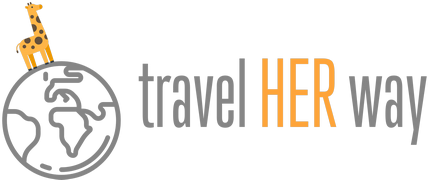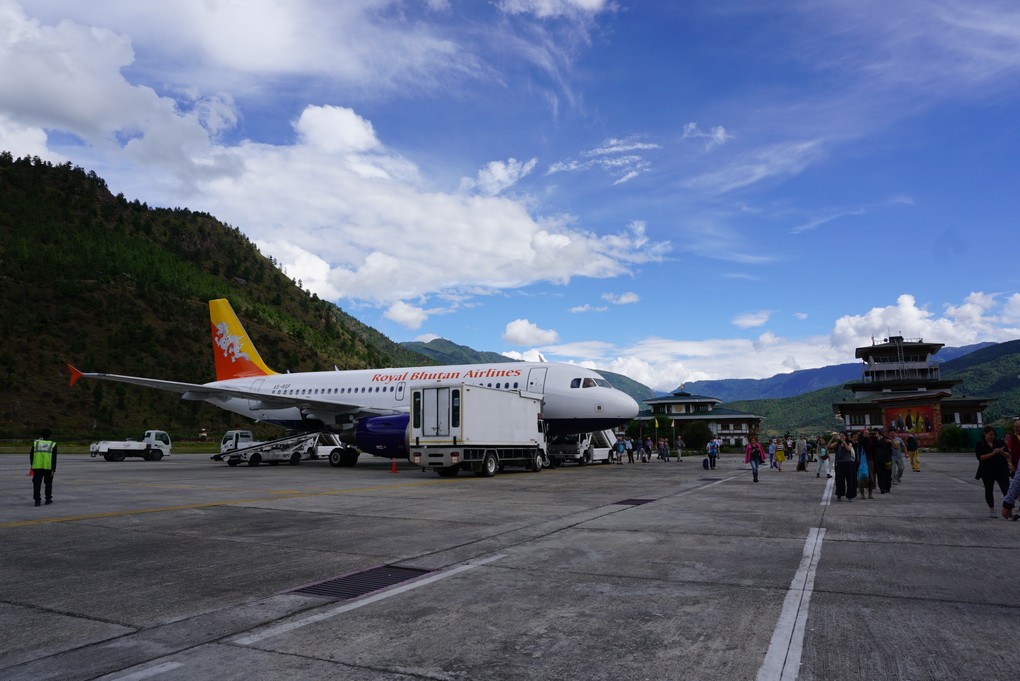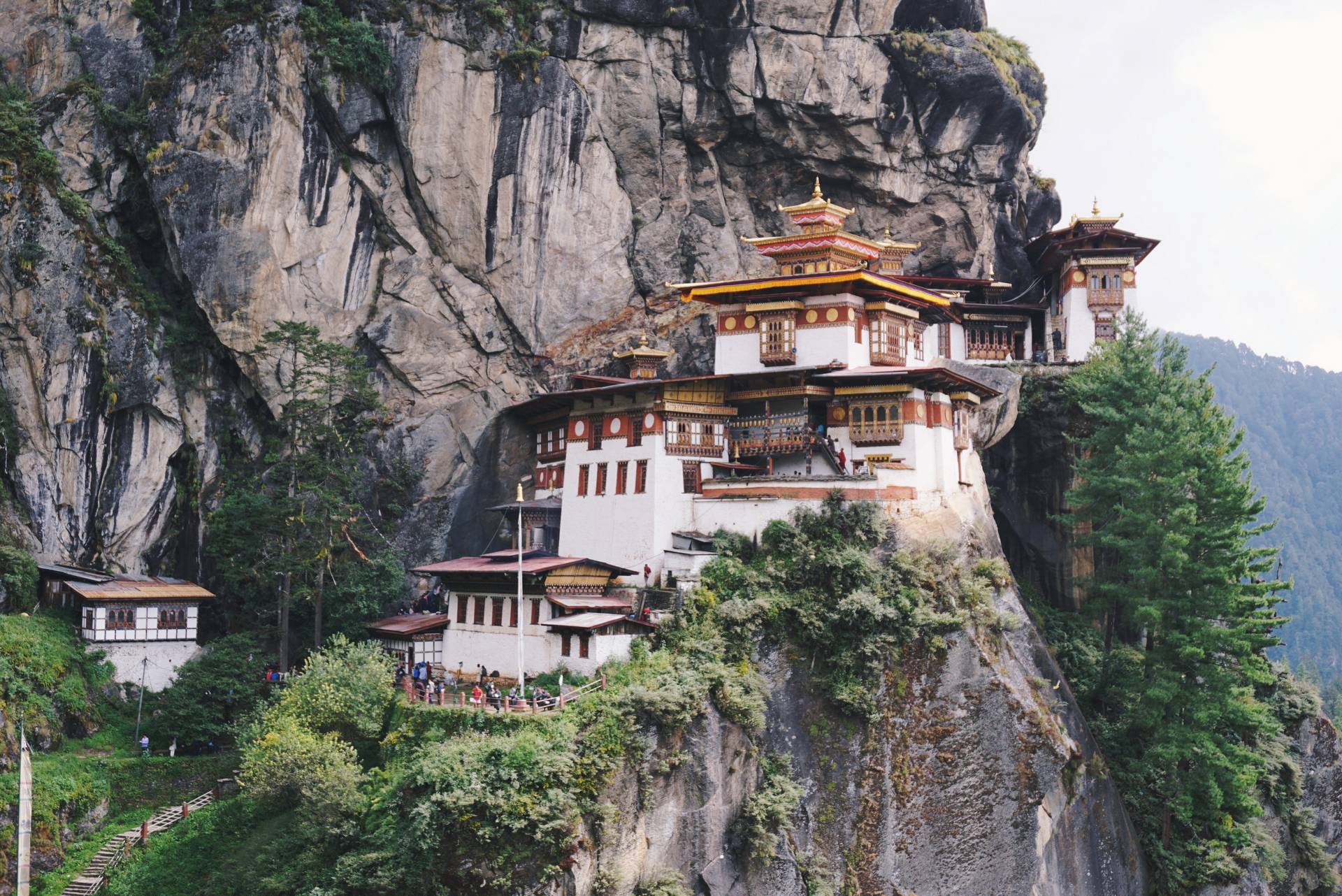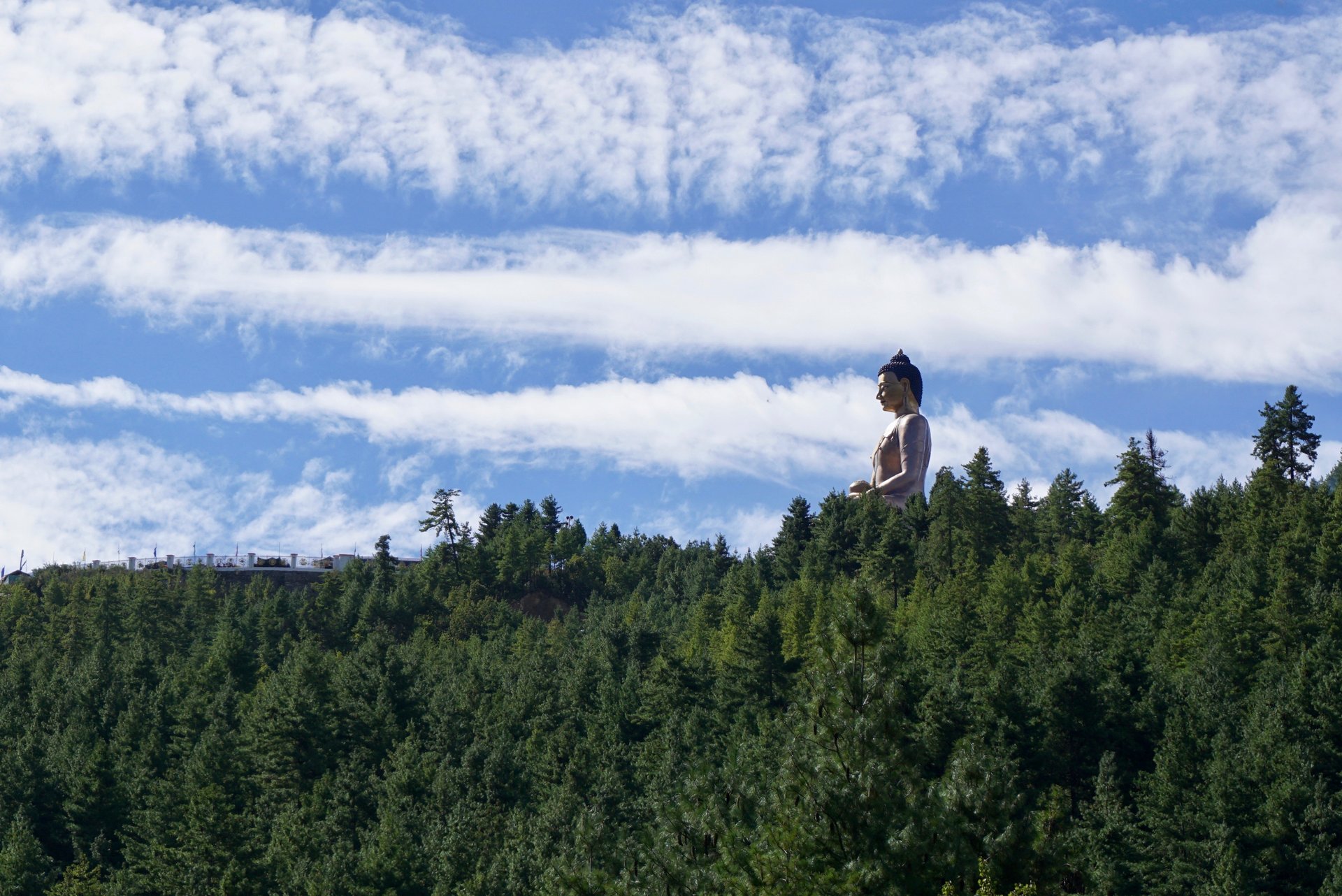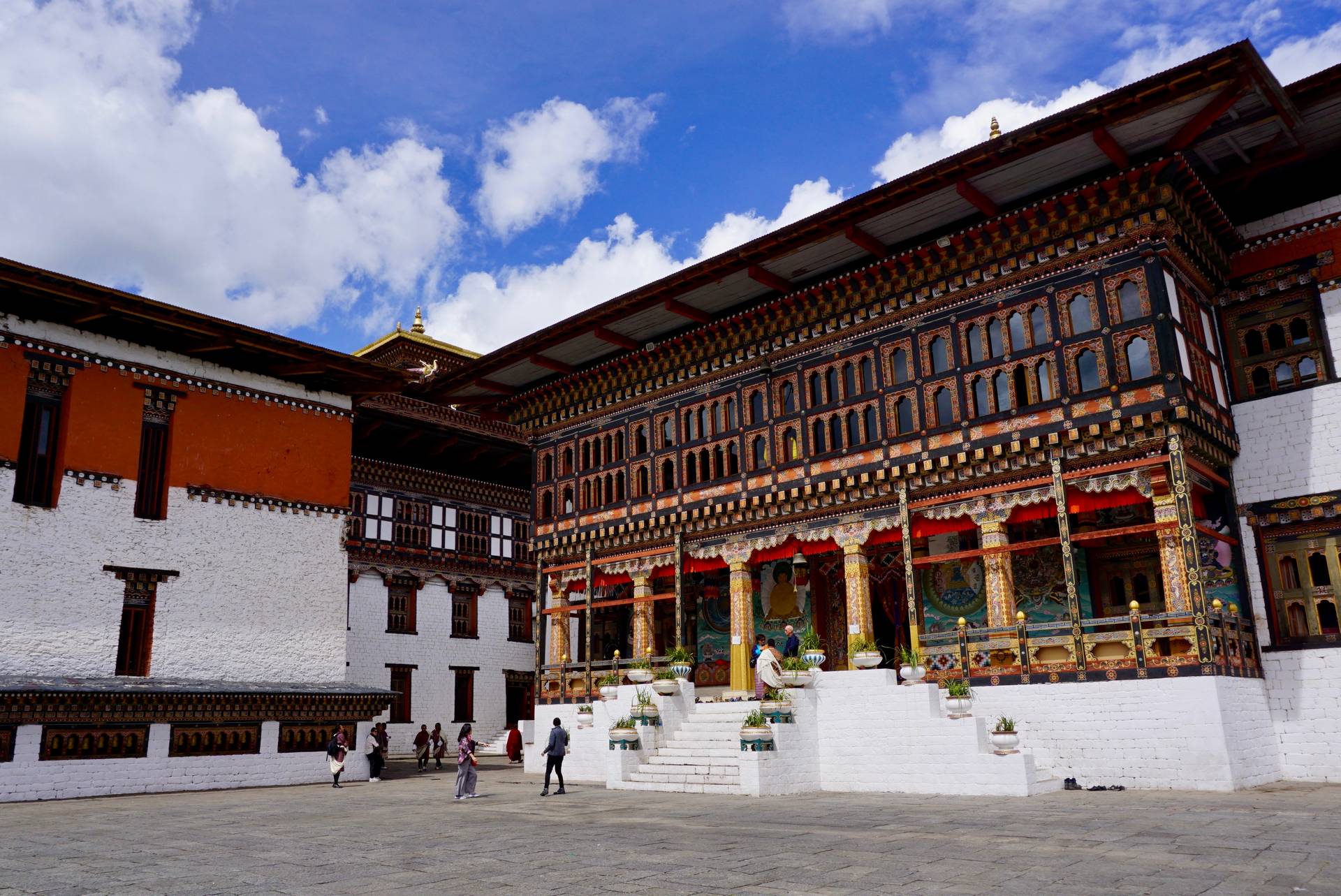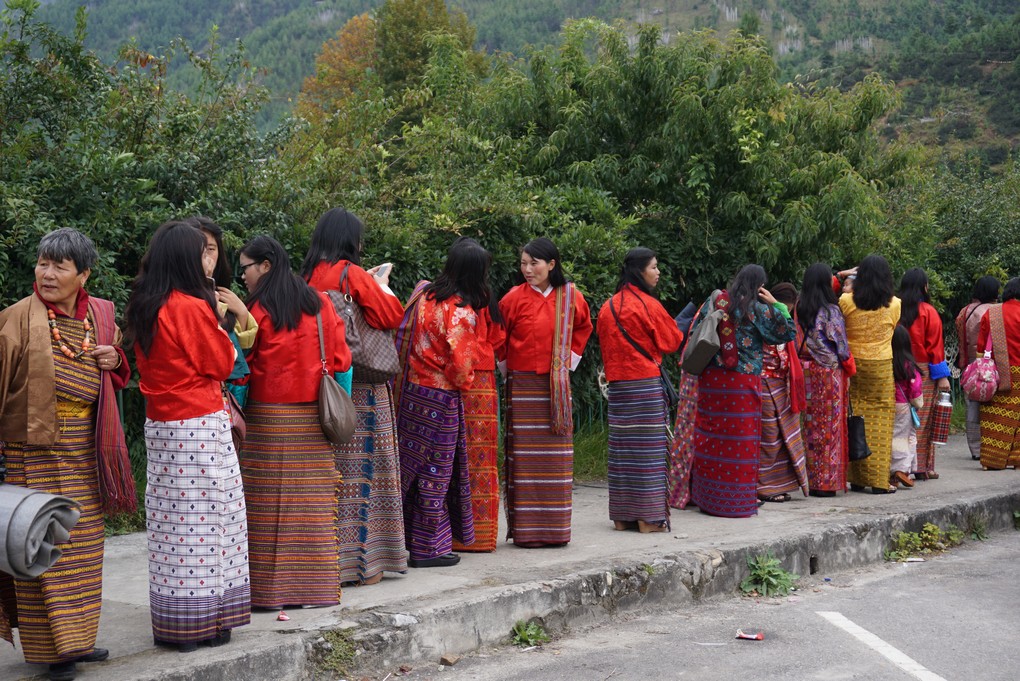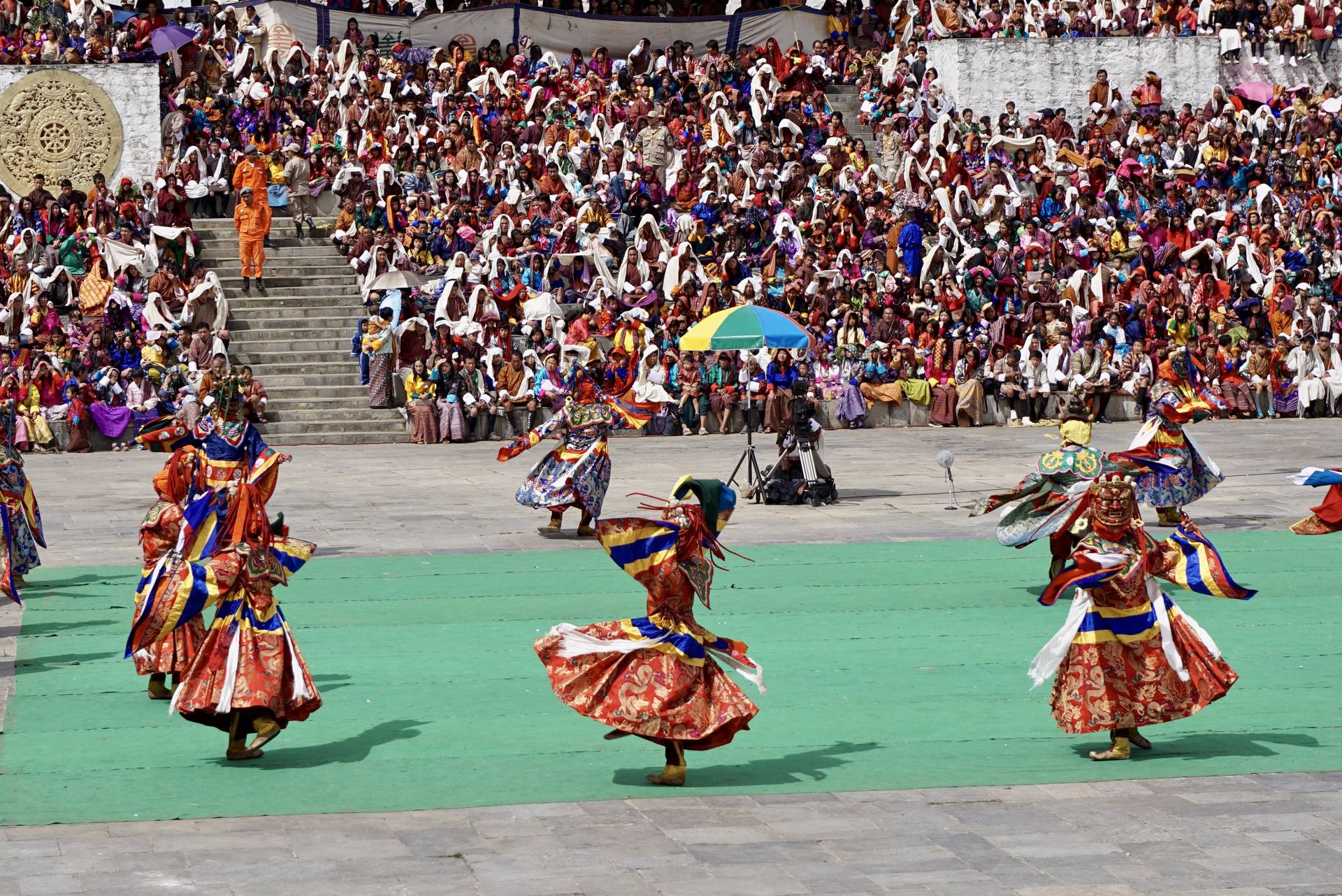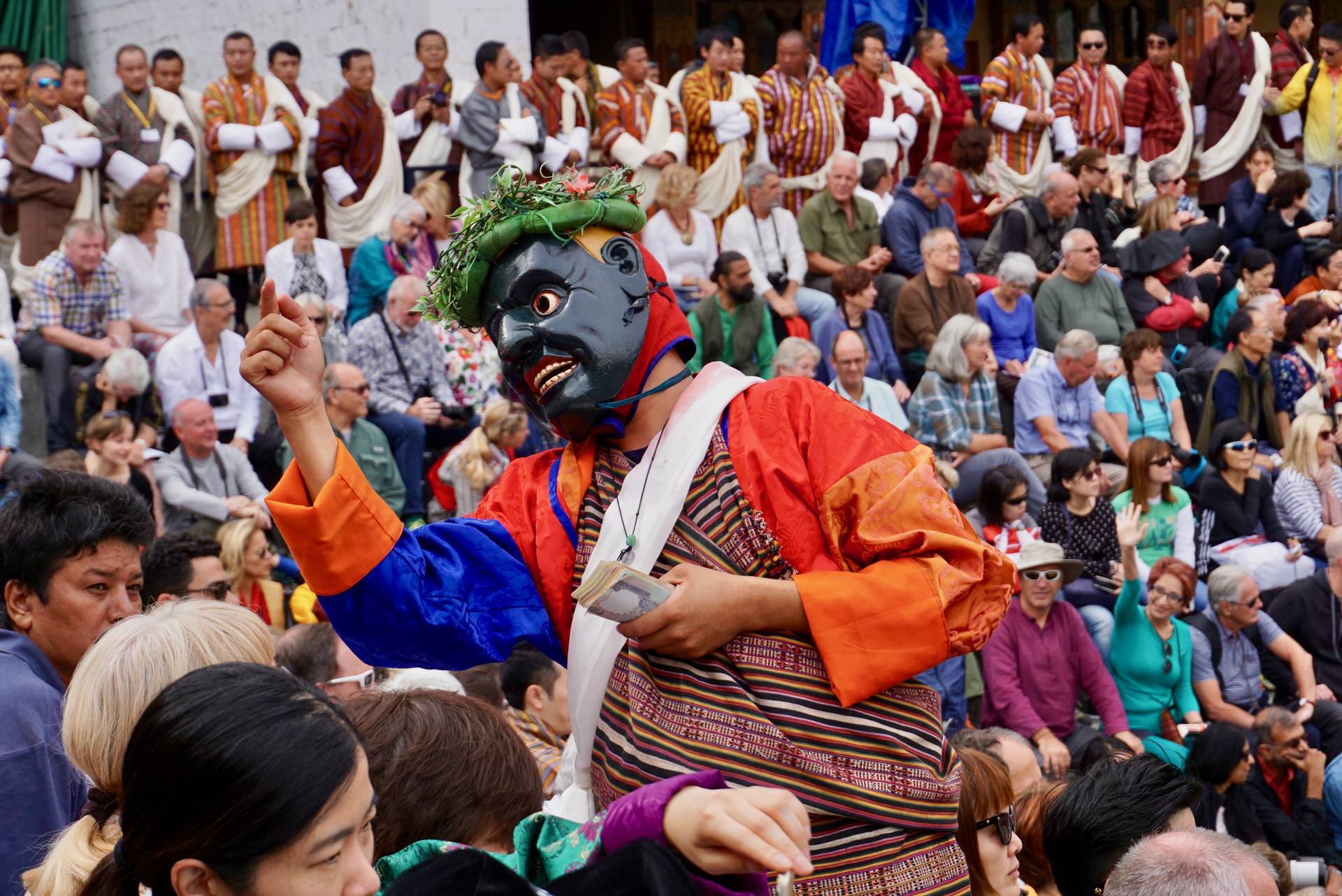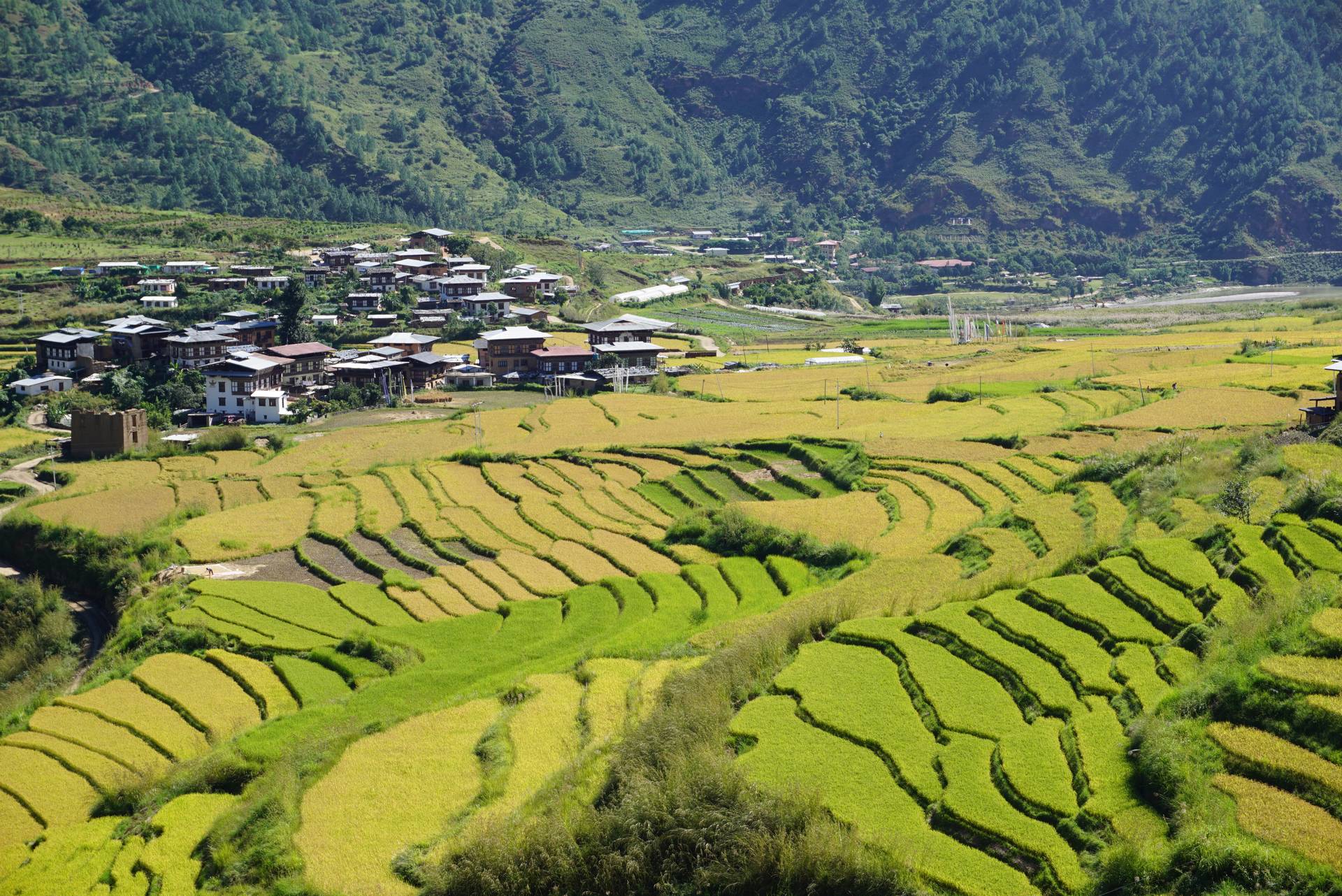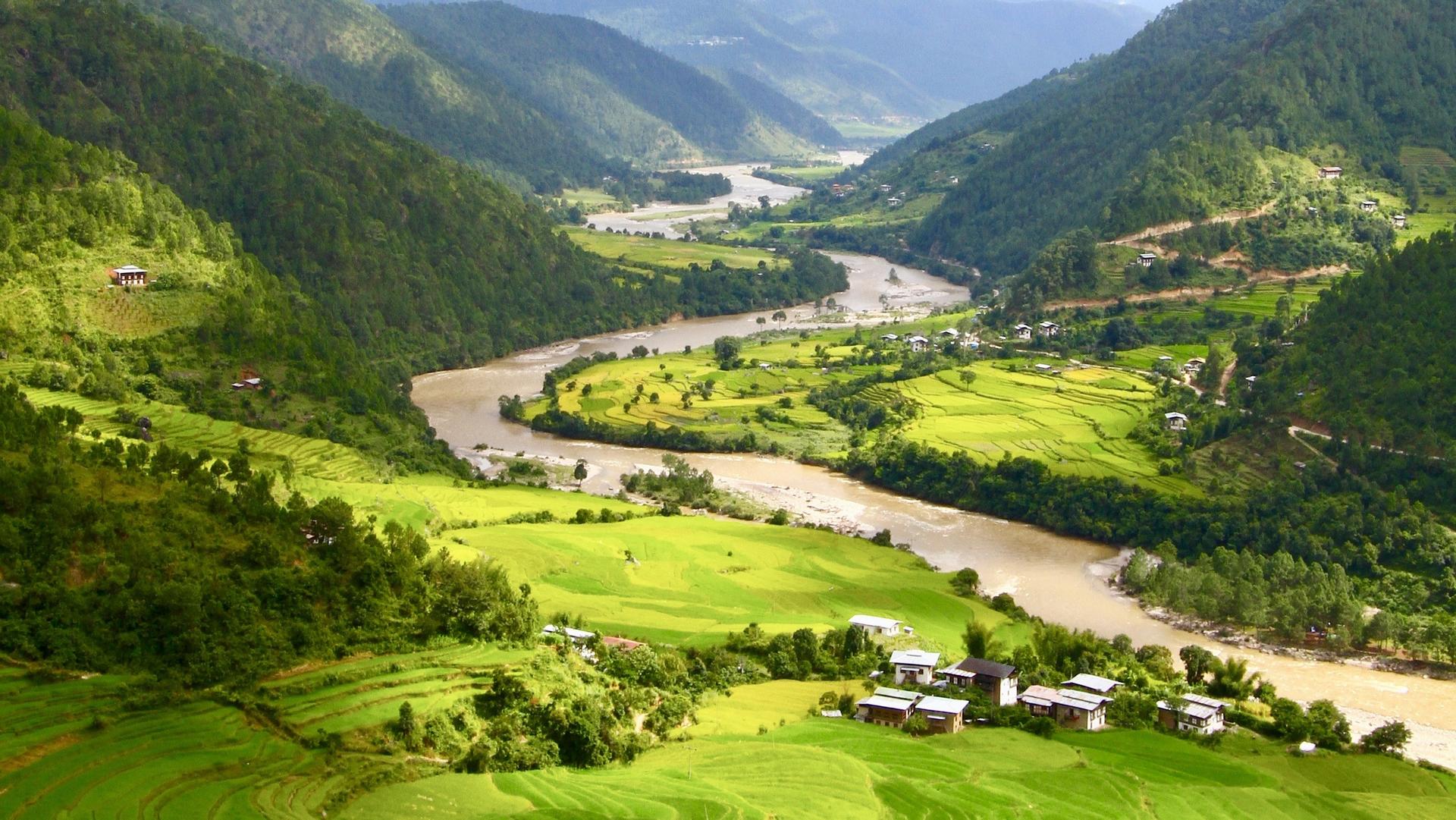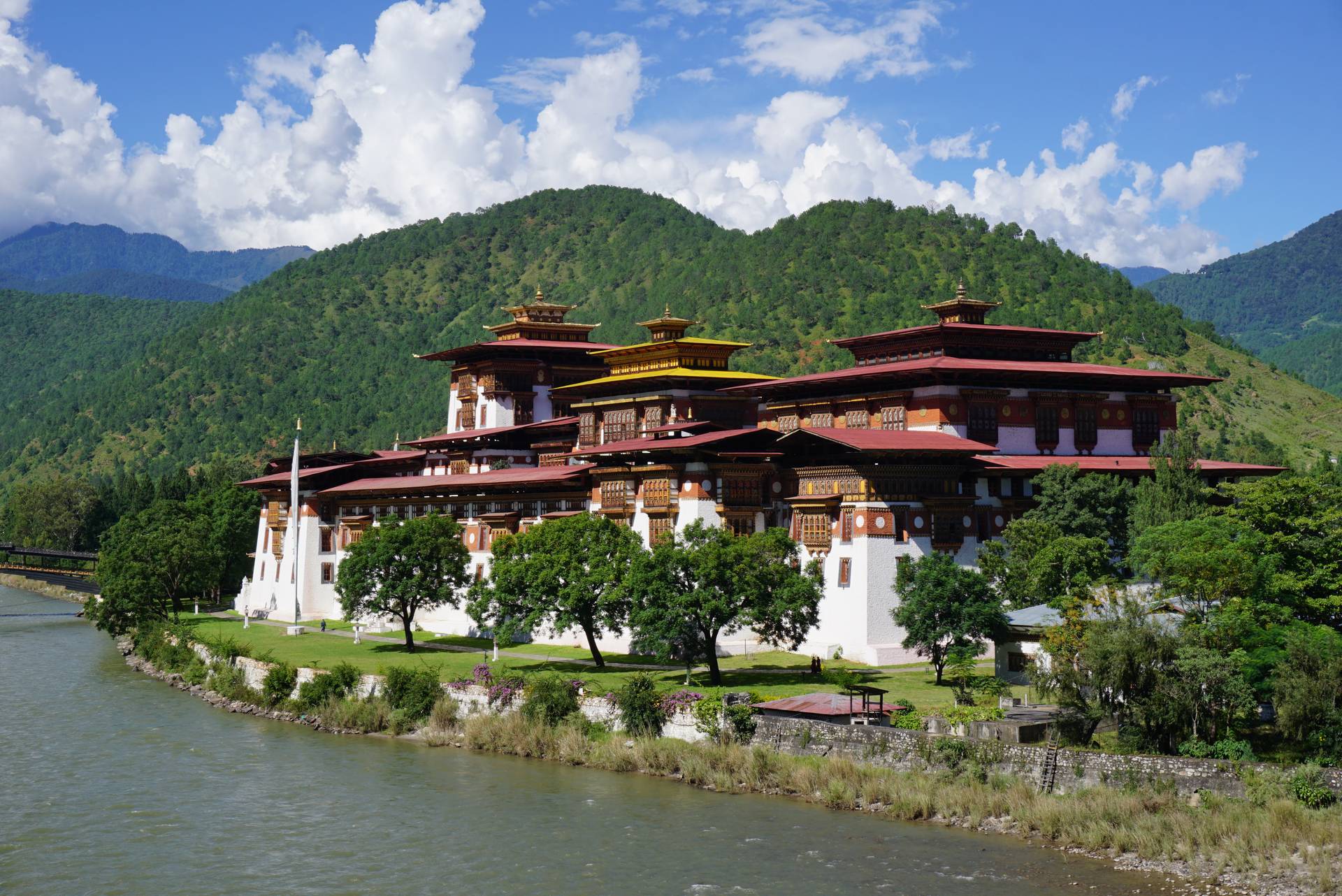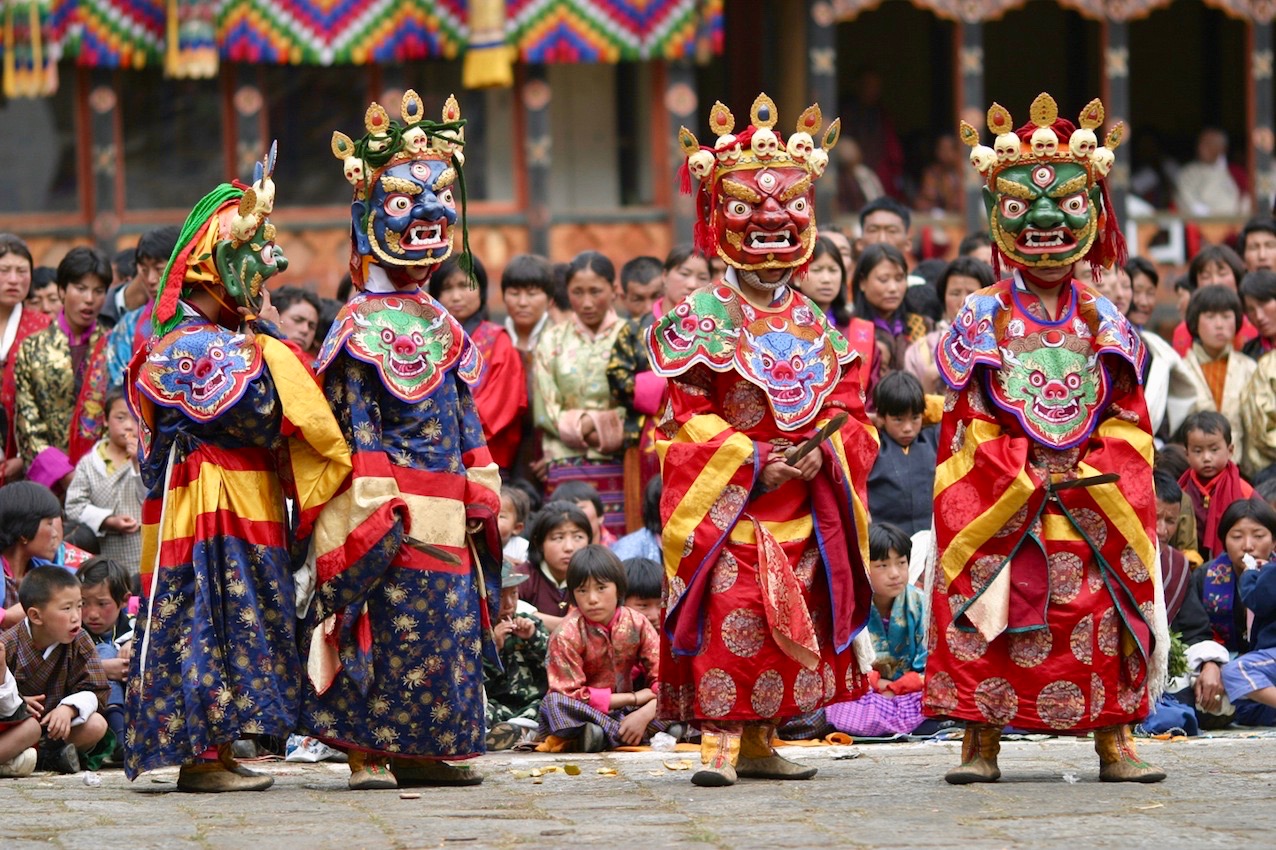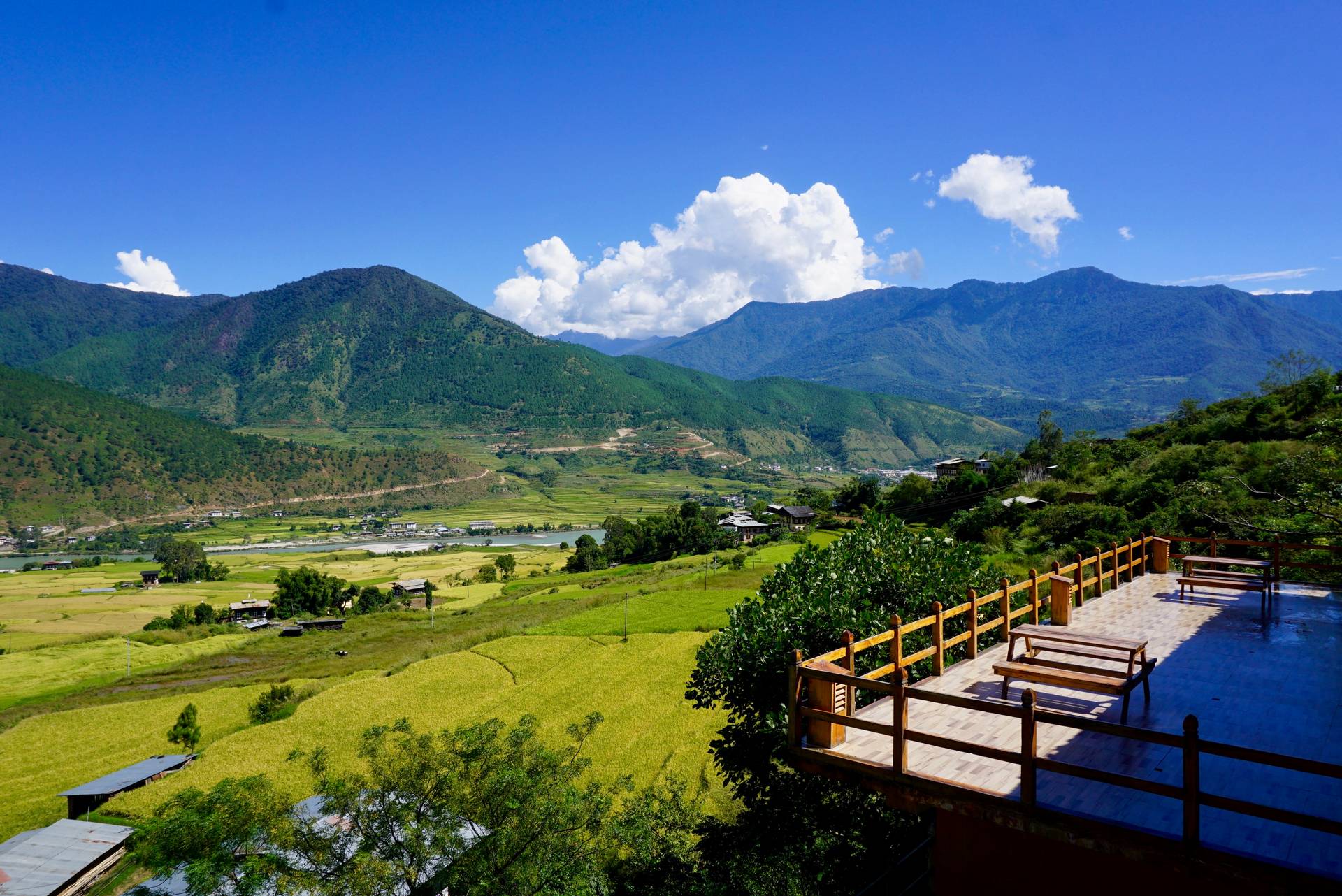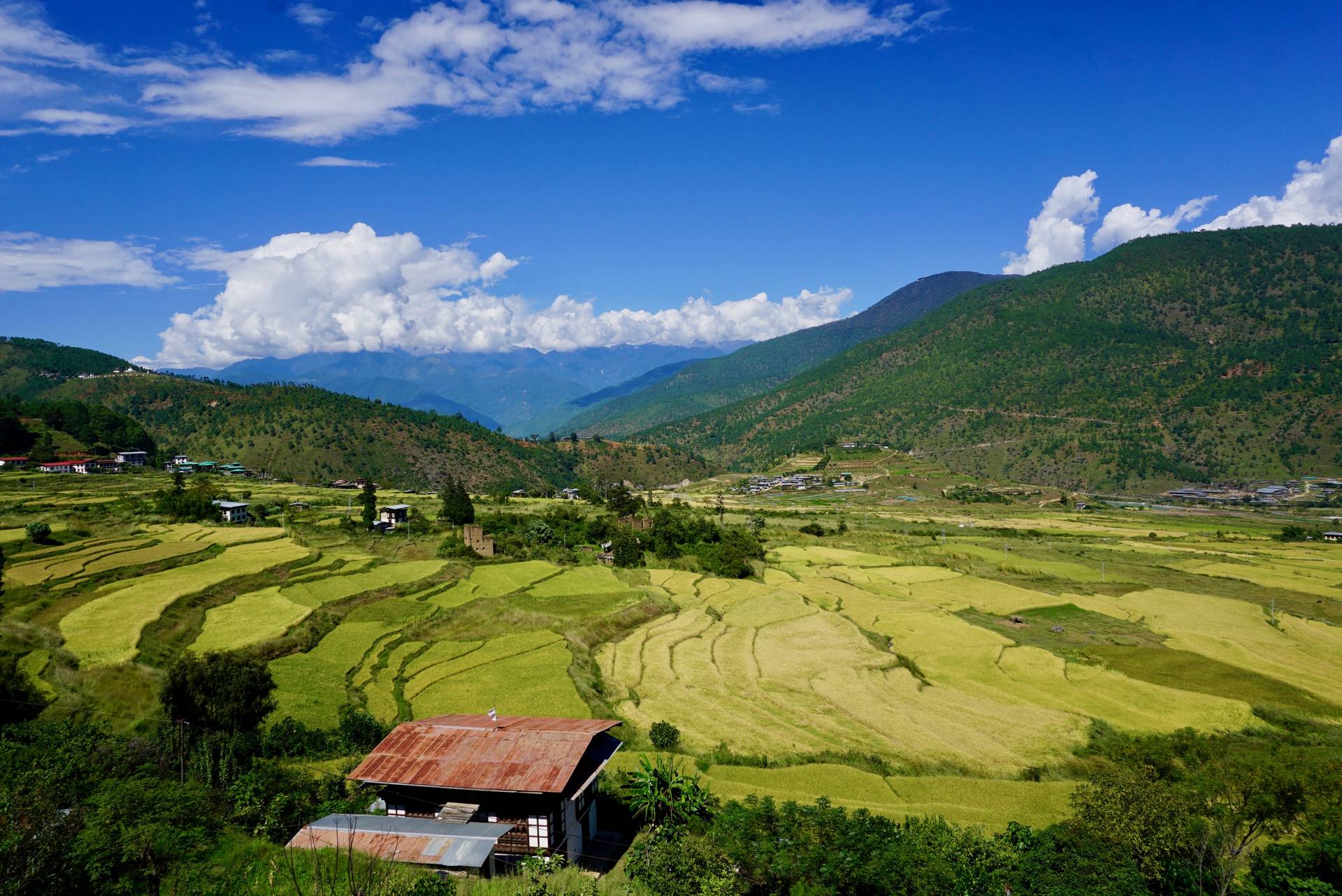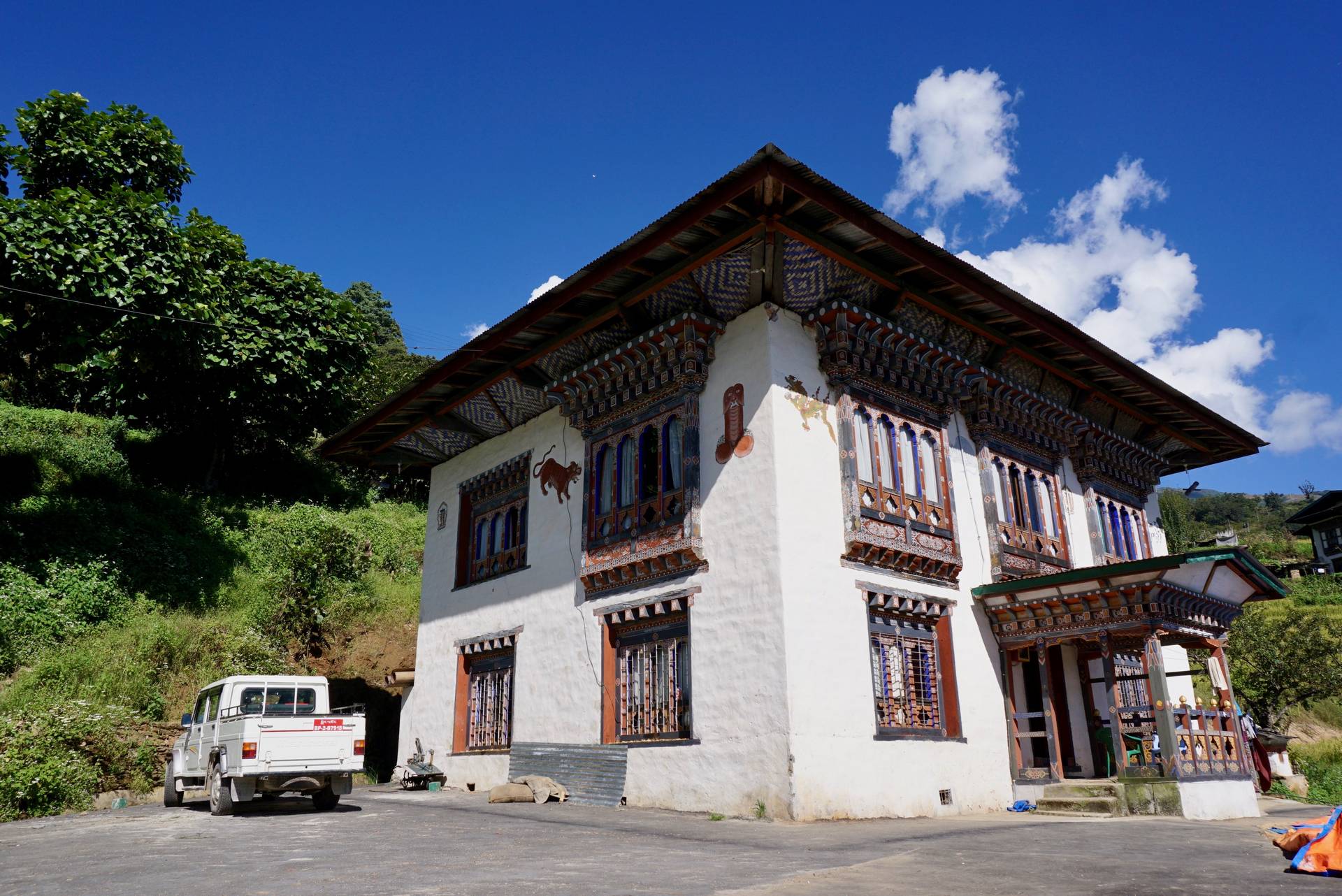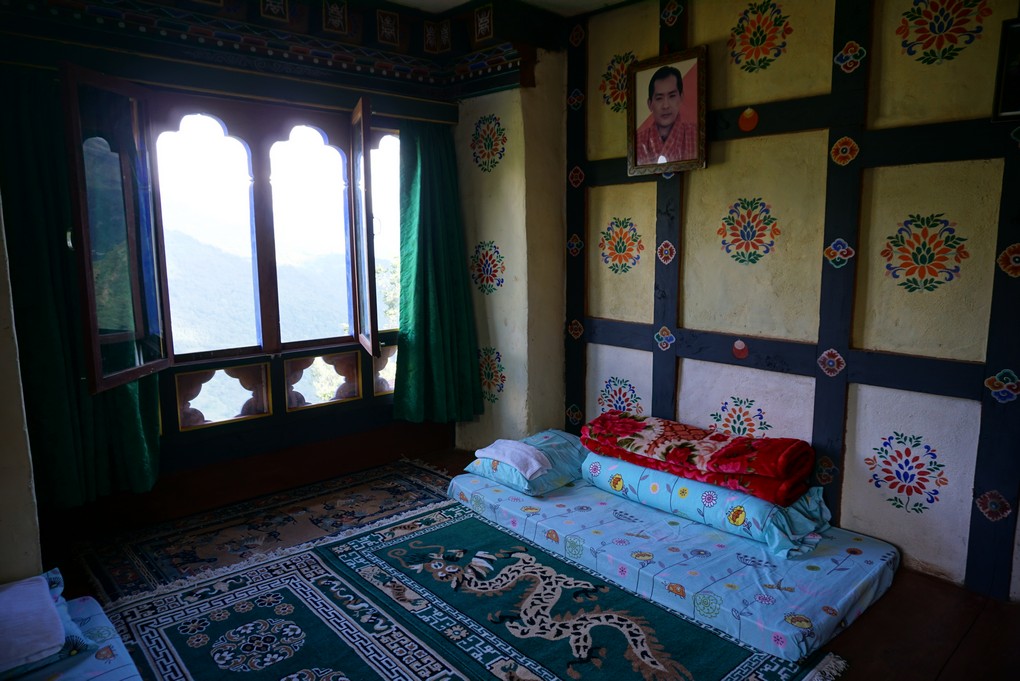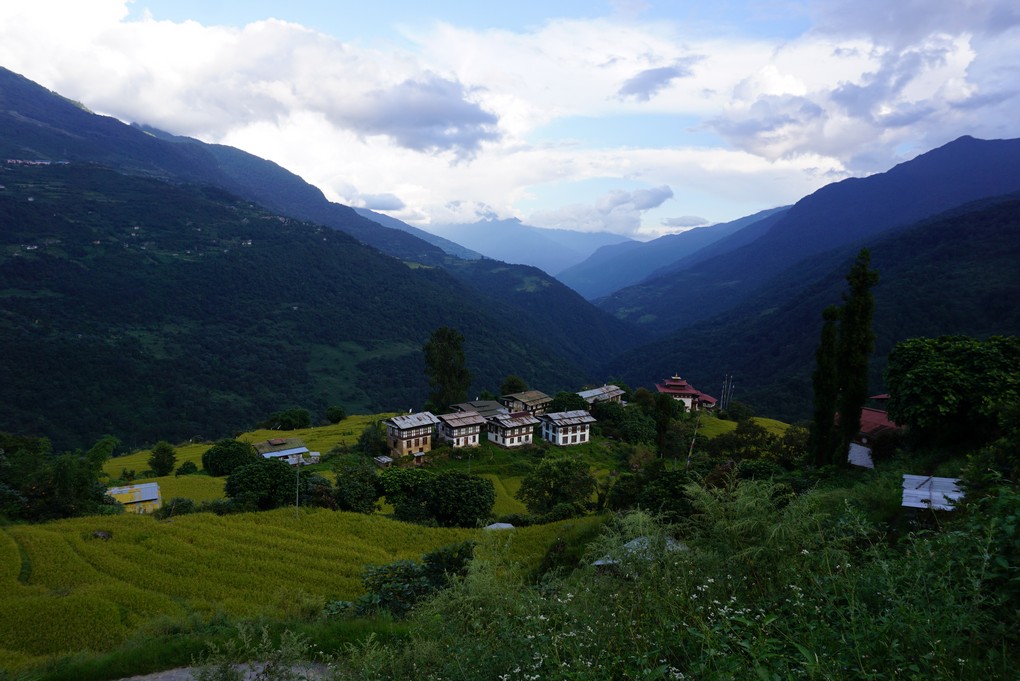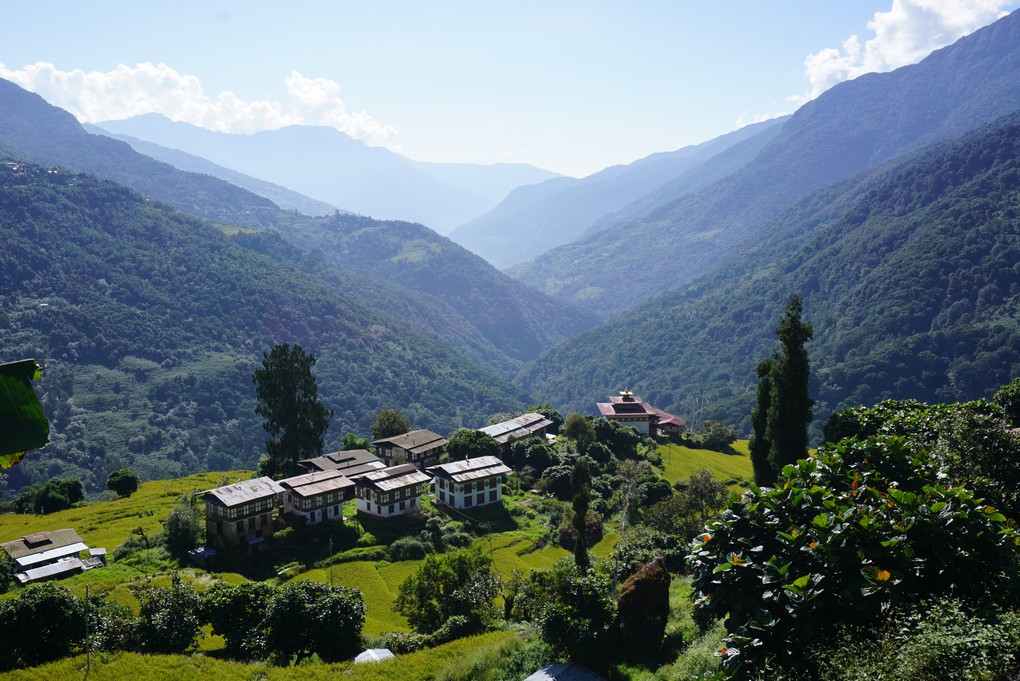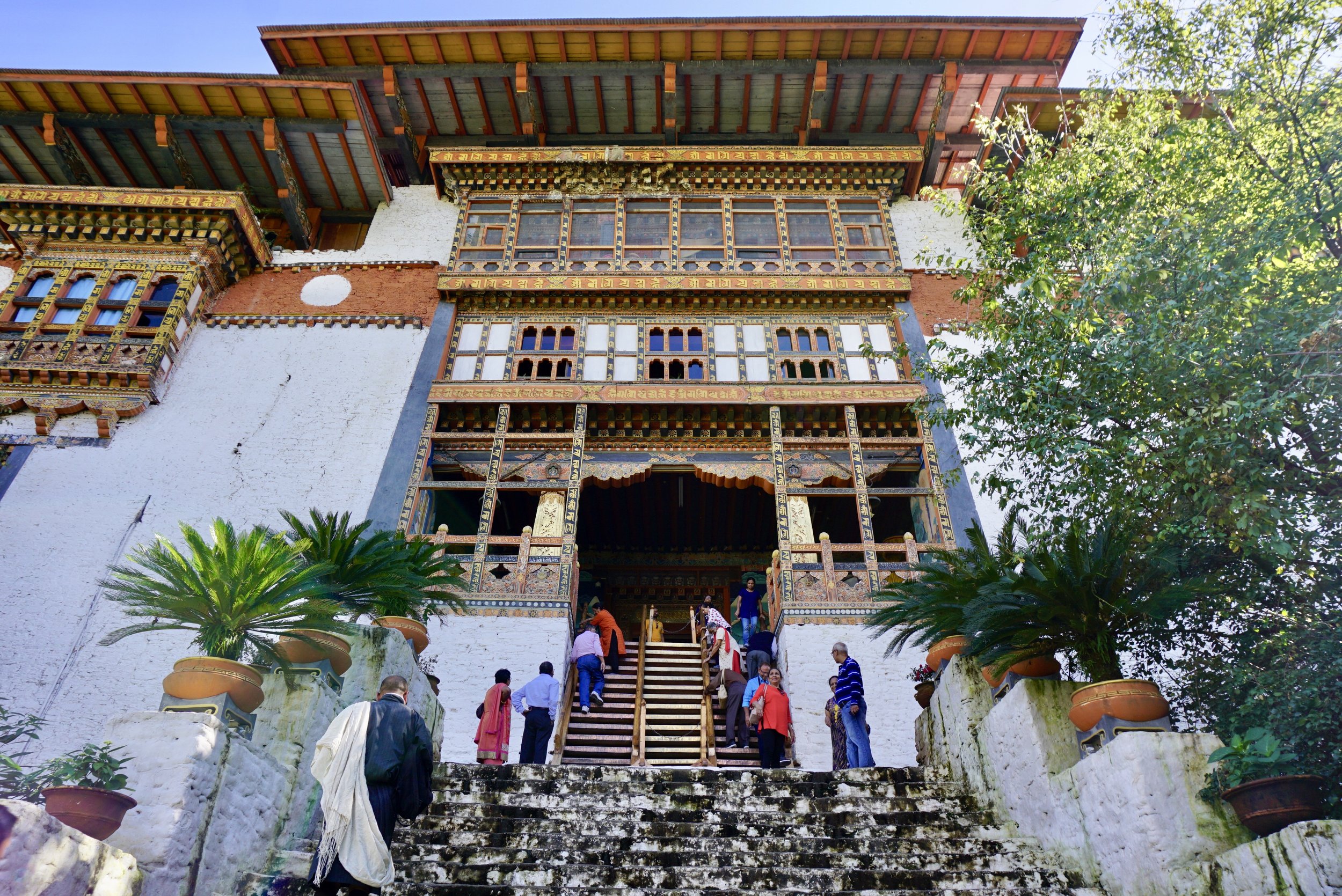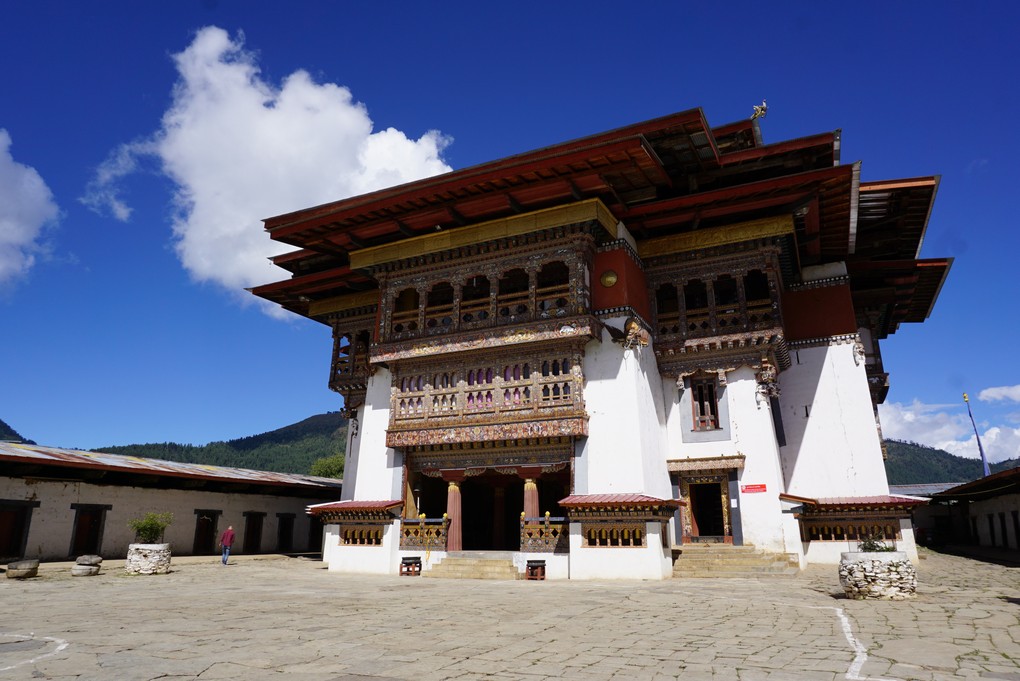Discover Bhutan + Festival
**Private trip only.
Length: 11 Days
Price (USD): $3,199
➤ Reserve your spot by making a $400 deposit which will never expire! Learn more about our lifetime deposit.
➤ Check out our Bhutan tour in spring!
Request to Book
Tucked away in the eastern edge of the Himalayas lies a garden of serenity, Bhutan. This landlocked kingdom is still wonderfully undiscovered, which helped preserve its Buddhist culture and traditional lifestyles. On this magical nine night journey, experience the last Mahayana Buddhist kingdom of the Himalayas, walk through dazzling rice fields, wander through serene monasteries and witness one of Bhutan’s spectacular local festivals and get connected with your spiritual self. Start off at the capital of Thimphu, then hike the valleys of Punakha, Thimphu, Phobjikha and Paro. Our tour will take care of the driving and logistics for you, ensuring that you get to explore more areas while making the most of your holiday.
Highlights of the TouR
- Explore the Bhutan culture and understand why Bhutan is considered the happiest country in the world.
- Experience Black Necked Crane Festival the way a local would: By wearing traditional Bhutanese garb to celebrate the arrival of this endangered and majestic bird.
- Explore lush, beautiful Bhutan landscapes on multiple day hikes.
- Lots of exclusive activities included: heritage farmhouse stay, outdoor yoga class, plant a tree, mountain biking tour, play Bhutanese archery, and herbal hot-stone bath.
- We only work with the best local service providers: our partner has over 10 years of experiences guiding tours in Bhutan, and is accredited by the Tourism Council of Bhutan (TCB) and is a member of the Association of the Bhutanese Tour Operators (ABTO).
Is this tour right for me?
Travel style: Outdoor & Culture
Service level: Standard
Clean and comfortable Tourist Standard hotels; private transportations; lots of included activities.
Physical rating: 2 - Moderate
Some moderate high-altitute day hikes.Age requirement: 15+
Travellers under 18 must be accompanied by an adult.Group size: min 1, max 12
Itinerary
Day 1: Paro - Thimphu
Arrive at any time and be transferred to Thimphu. Enjoy a welcome dinner and meet the team.
Day 2: Thimphu
Enjoy panoramic views of the capital city, hike to the beautiful Changangkha Monastery and end the day at the vegetable market and the Changlimithang Stadium.
Day 3: Thimphu
Embrace the Bhutanese culture by paying a visit to the National Folk Heritage Museum, the Textile Museum and the Bhutan Post Office.
Day 4: Thimphu - Punakha
Ride in air-conditioned vehicle to Punakha and enjoy the Lungtsezelkha Hike with blossomed alpine vegetations. End the day by visiting one of Bhutan’s most charming and eccentric historic figures, the Chhimi Lhakhang.
Day 5: Punakha
Walk through a scenic trail to Khamsum Yuelley Namgyal stupa and enjoy a picnic lunch served at the bank of the Punakha River. Overlook the valleys of Punakha and Wangduephodrang and interact with nuns at the Sangchhen Dorji Lhuendrup Lhakhang Nunnery.
Day 6: Punakha - Tangsibje
Live like a local at the scenic Tangsibje village while staying in a heritage house built in the 1960s. Be welcomed with a traditional ceremony with songs and music and a splendid authentic dinner.
Day 7: Tangsibje - Phobjikha
Wake up to the sounds of the village and experience the authentic rural lifestyle. Spend time learning archery with the locals and visiting temples. Later, you’ll be driven to Phobjikha Valley.
Day 8: Phobjikha Valley: Black Necked Crane Festival
Witness one of Bhutan’s most unique community festivals - the Black Necked Crane Festival. Join in with the locals to rejoice and celebrate the arrival of this endangered majestic bird.
Day 9: Phobjikha - Paro
Drive to Paro. On the way there, visit the oldest Dzong in the country, the Simtokha Dzong, and one of the oldest temples, Kichu Lhakang. Explore the historic town of Paro, rich with many sacred sites and historic buildings.
Day 10: Paro: Excursion to Tiger’s Nest
Last, take a trip to the Himalayan Buddhist sacred site, the Taktshang Monastery, a famous temple built in 1692. In the evening, try an herbal hot-stone bath and end the trip exploring the town.
Day 11: Departure
Depart at any time.
Similar Tours
Day 1: Paro - Thimphu (Driving time: 1 hour)
The flight into Bhutan gives a scenic and dazzling view of the world’s highest glacial peaks. After passing through customs and visa control, our professional guide will drive you to the capital city of Thimphu. On the way, our friendly guide will make a brief stop to visit the iron bridge, Tamchong Lhakang. After settling in at the hotel, feel free to take a walk and visit the Memorial Chorten Stupa. End the day with a welcome dinner at one of Thimphu’s best authentic Bhutanese restaurants.
- Memorial Chorten Stupa: : This Tibetan-style chorten is located close to the center of Thimphu city and is one of the most prominent religious structures in Thimphu. Built in 1974 as a memorial to the third king, Jigme Dorji Wangchuck, it is a large white structure crowned with a golden spire, and for many Bhutanese it is the focus of their daily worship.
Accommodations & Meals:
Accommodations: Bhutan Suites (Value Added) or Hotel Pedling
Meals: Welcome Dinner
Day 2: Thimphu Sightseeing
Make sure to wear comfortable shoes, as we will spend the day exploring. We will see the 169 ft statue of Buddha Dordenma overlooking the Thimphu valley, hike to the spectacular Changangkha monastery, and practice a yoga session at the Kuenselphodrang Nature Park. All of these sites will afford a view of the beautiful city of Thimphu from afar.
Stepping out of the city, we will visit a child daycare center and learn more about the education system in Bhutan. Afterwards, we will get to know more locals in the colorful vegetable market where farmers from all over Bhutan come and sell their goods. We will even pay a visit to see the national animal of Bhutan, the takin!
End the day in one of Thimphu’s best restaurants to savor authentic Bhutanese cuisine.
- Kuensel Phodrang (Buddha Point): Kuensel Phodrang is the site of the 169 foot statue of Buddha Dordenma that overlooks the Thimphu Valley. Made of bronze and gilded in gold, this is one of the largest statues of Buddha in the world. Inside, find a spectacular number of smaller gilded Buddha statues - 125,000, to be exact. From Buddha Point, you may take in the panoramic view of Thimphu city.
- Takin Reserve Center: The takin, the national animal of Bhutan, is a goat-antelope native to the eastern Himalayas. The reserve center is a great way to learn about and view the takin in its natural environment, and it also offers a great view of Thimphu City.
- Changlimithang Stadium: Built on the site of a battle fought in 1885, the stadium was rebuilt in 1974 as a multi-use stadium. Most days, you can watch locals enjoying the national sport, archery. Played in the traditional style over a 120m long range, watching the Bhutanese practice archery is always a fun way to experience local flavor.
- Travel HER Way exclusives: Yoga at Kuenselphodrang Nature Park
While enjoying the beautiful view of Thimphu city at the park, we will practice a yoga session instructed by our certified Yoga teacher.
- Travel HER Way exclusives: Plant a tree
On our way to Kuensel Phodrang, each of us will be given a tree sapling. We will plant the tree and each of the tree will be taken care by Our local friends for at least a month.
Accommodations & Meals:
Accommodations: Bhutan Suites (Value Added) or Hotel Pedling
Meals: Breakfast, Lunch, Dinner
Day 3: Thimphu Sightseeing
Learn more about Thimphu’s cultural traditions by visiting the National Folk Heritage Museum, the Zorig Chusum School of 13 Traditional Arts/Crafts, the Textile Museum and the Bhutan Post Office to see the diverse collection of stamps and philatelic history.
In the afternoon, we will continue to the northern part of the valley to Begana village. Here, we will hike to the popular Tango monastery through the Rhododendron forests. In the evening, learn about traditional healing and wellness practices at the Institute of Traditional Medicine and end the day visiting the Tashichho Dzong.
- National Folk Heritage Museum: Once a 19th century traditional Bhutanese farm house, the National Folk Heritage Museum provides a glimpse into Bhutanese lifestyle, holding artifacts from rural households.
- The Bhutan Post Office: A surprisingly popular place to visit, the Bhutan Post Office displays a rich collection of stamps significant to Bhutan’s history. Here, guests can learn about how stamps have influenced Bhutanese culture, and even get their pictures on a stamp to send postcards to loved ones.
- The Institute of Traditional Medicine: Be amazed by the myriad collection of Himalayan herbs used in the traditional healing system and wellness practices.
- Tashichho Dzong: Built in 1216 and once a Buddhist monastery and fortress, now the Tashiccho Dzong acts as the government’s central administration headquarters. It is also the offices of the King and the Prime Minister and is one of the major attractions of Thimphu.
- Travel HER Way exclusives: Mountain Biking (Optional)
For outdoor enthusiasts, join us for a mountain bike tour. Our experienced leader will take you to explore the adventurous side of Bhutan. Detailed information about time and bike route will be shared in the morning on that day.
- Travel HER Way exclusives: Night Out in Thumphu
Enjoy some local craft beer and live music in one of the most popular bars in Thimphu.
Accommodations & Meals:
Accommodations: Bhutan Suites (Value Added) or Hotel Pedling
Meals: Breakfast, Lunch, Dinner
Day 4: Thimphu - Punakha (Driving time: 3 hours)
We will begin the day driving to Punakha over the Dochula Pass. From there, we will hike the Lungtsezelkha trail, which passes through the Rhododendron forest and alpine vegetation – in full bloom during this time of year.
When returning from the hike, take a walk through the low-lying rice valley of Lobesa. Here, we will be able to pay our respects to one of Bhutan’s historic figures at the Chhimi Lhakhang. We will also take a short hike through a beautiful village surrounded by paddy fields.
- Druk Wangyal Chortens: Situated atop of the Dochula Pass, the Druk Wangyal Chortens consists of 108 chortens (stupas) that were built to exemplify the greatness of the Fourth King.
- Lungtsezelkha Hike: This lovely and moderate hike passes through the Rhododendron forest, where alpine vegetation will be in full bloom. Yaks are often spotted. Starting from the Dochula pass (3150m), climb up to the Lungtsezekha Temple (3800m) and see the Greek Himalayan peaks of northern Bhutan.
- Chhimi Lhakhang: The Chhimi Lhakhang is a Buddhist monastery and home to one of Bhutan’s most charming and eccentric historic figures nicknamed ‘The Divine Madam.’
- Travel HER Way exclusives: Visit to Draktsho Vocational Training Institute
Draktsho Vocational Training Institute is dedicated to help children with disabilities in Bhutan. We will pay a short visit to the institute. You may also help by donating used books, stationeries and other educational materials.
Accommodations & Meals:
Accommodations: Meri Phuensum or Hotel Lobesa
Meals: Breakfast, Lunch, Dinner
Day 5: Punakha
We will begin the day by driving to the Khamsun Yuelley Namgyal stupa, where we will also take a short scenic hike through the paddy fields to get to the temple. Here, we can take in the majestic view of the underlying Punakha valley. A picnic will be served on the banks of the Punakha River. Afterwards, we will continue to Punakha Dzong, the most beautiful fortress in Bhutan. We will end our day at the Sangchhen Dorji Lhuendrup Lhakhang Nunnery, which overlooks the valleys of Punakha and Wangduephodrang.
- Khamsum Yuelley Namgyal Stupa: A short, scenic hike through paddy fields in Yepaisa Village leads to get to this temple at the top of a hill. From here, enjoy majestic views of the underlying valley. With its exterior in the form of a pagoda and its interior containing images of dieties, the temple is a perfect example of Bhutan’s fine architectural and artistic traditions.
- Punakha Dzong: Both a beautiful fortress and a major administrative center, the Punakha Dzong is at the confluence of two rivers. The ancient fortress is the winter residence of the monastic order’s leadership and still serves as the administrative headquarters for the Punakha region.
- Sangchen Dorji Lhuendrup Lhakhang Nunnery: This nunnery is a large temple complex that acts as a meditation center for its nuns, who are always open and eager to speak with English-speaking visitors and learn about their culture. In addition to allowing its visitors to listen to prayers, the nunnery also offers great views that overlook the valleys of Punakha and Wangduephodrang.
Accommodations & Meals:
Accommodations: Meri Phuensum Resort or Hotel Lobesa
Meals: Breakfast, Lunch, Dinner
Day 6: Punakha - Tangsibje (Driving time: 5 hours)
After breakfast, take a trip to Tangsibje to stay with a local family in a heritage house built in the 1960s in the beautiful villages of the Trongsa district.
The host family will welcome you with a traditional chipdrel ceremony consisting of songs and music, and you will enjoy a splendid dinner prepared with fresh organic vegetables and herbs from the host family’s garden. There will be a cultural evening showcase, where you will be encouraged to share some songs from your culture too! No other tour operator provides such first-hand access to the authentic, rustic lifestyle of Bhutan.
- Travel HER Way exclusives: Heritage Farm House Stay
Stay one night in the heritage farm house in Tangsibje. We will eat and sleep like a local.
Accommodations & Meals:
Accommodations: Local Heritage Farmhouse
Meals: Breakfast, Lunch, Dinner
Day 7: Tangsibje - Phobjikha (Driving time: 4 hours)
Live like the locals of Tangsibje as you wake up to the sounds of the village. Then you will have your choice of many local activities: You can learn how to help make a Bhutanese-style breakfast, take a walk around the village to visit temples, play a traditional dart game called Khuru, or learn how to perform archery in the Bhutanese style.
Afterwards, we will drive to Phobjikha Valley. Walking into this idyllic valley, secluded and remote, instantly lifts the spirit. As you walk through the scenic nature trail around the Phobjikha Valley, the hike ends at the famous Gangtey Gonpa temple. This monastic school is the biggest Nyingma monastery in Central Bhutan.
- Travel HER Way exclusives: Play Bhutanese Archery
The host will teach us how to play Bhutanese archery. It is one of the most favorite games by villagers.
Accommodations & Meals:
Accommodations: Dewachen Resort or Kyichu Resort
Meals: Breakfast, Lunch, Dinner
Day 8: Phobjikha Valley: Black Necked Crane Festival
Be a part of one of Bhutan’s most unique community festivals. The Annual Black-necked Crane Festival is celebrated in the courtyard of Gangtey Gonpa in Phopjikha valley. The festival is as much to rejoice and celebrate the arrival of the endangered bird as it is to increase awareness of the importance of its conservation. It is a way to strengthen the links between conservation, economic welfare and the livelihood of the community.
The festival includes folk songs, a variety of dances performed by the locals, and environmental conservation-themed dramas and songs performed by school children.
Accommodations & Meals:
Accommodations: Dewachen Resort or Kyichu Resort
Meals: Breakfast, Lunch, Dinner
Day 9: Phobjikha - Paro (Driving time: 6 hours)
Begin the morning with a drive to Paro Valley, an historic town with many sacred sites and buildings. Recognized as one of the most beautiful towns in Bhutan, Paro Valley is considered the rice bowl of the country.
En route, we will visit the Simtokha Dzong and Kichu Lhakang. Once we get to Paro, stroll around and enjoy the evening and night at the hotel.
- Simtokha Dzong: Meaning “castle-monastery,” the Simtokha Dzong stands on a lofty ridge and now houses the Institute of Language and Cultural Studies. It was opened in 1629, which makes it the oldest Dzong in Bhutan.
- Kichu Lhakang: One of the oldest temples dating back to the 7th century, Kichu Lhakang was built by Tibetan king, Songchen Gyampo, to propagate Buddhism.
Accommodations & Meals:
Accommodations: Gangtey Palace or Metta Resort
Meals: Breakfast, Lunch, Dinner
Day 10: Paro: Excursion to Tiger's Nest (3,048m/10,000ft)
Experience Bhutan’s most valued attraction, the famous Taktshang Monastery, meaning “Tiger’s Nest Monastery.” We will also visit the ruins of Drugyal Dzong fortress. After lunch in Paro, we will see the Paro Rinpung Dzong fortress and hike up the National Museum that houses some of the most treasured collections of Bhutanese art, artifacts, textiles, stamps and statues.
Later, get in touch with your therapeutic side with an herbal hot-stone bath to soothe the mind and body. In the evening, explore the town or visit handcrafted shops.
- Tiger’s Nest Monastery: This temple was built in 1692 by a historical figure named Gyaltse Tenzin Rabgye. Legend is that this builder was the reincarnation of the 8th century guru, Padmasmabhava. Our group has the opportunity to meditate in the inner shrines of the monastery.
- Drugyal Dzong Fortress: This fortress and Buddhist monastery, now in ruins, is an important part of Bhutanese heritage. It served as a strategic watchtower and fortress that helped repel numerous Tibetan invasions in the 1600s.
Accommodations & Meals:
Accommodations: Gangtey Palace or Metta Resort
Meals: Breakfast, Lunch, Dinner
Day 11: Departure
Depart at any time. Our driver will transfer you to the airport for your journey home.
What's Included
Bhutan Tourism Royalty fee ($65/day/person)
Bhutanese visa arrangement and visa fee ($40/person)
All required permits and entrance fee for sightseeing
Experienced local English-speaking guide and driver
Airport pick-up and drop-off by private vehicle
Drinking water
Accommodations(on twin-sharing basis):
- Hotel (9 nights); Farm House (1 night)
Meals:
- All meals during the trip
Transportation:
- Private vehicle
Travel HER Way exclusive activities:
- Outdoor Yoga class (Kuenselphodrang Nature Park)
- Care Her Way: Plant a tree
- Care Her Way: Visit Draktsho Vocational Training Center (a training institute for children and youth with disabilities)
- Mountain biking tour
- One-night heritage farm house stay
- Learn & play Bhutanese archery
- Herbal hot-stone bath
Need Your Own Room?
Bedding are limited during peak season. Please contact us if you would like to have your own roon. We will try our best to accommodate to your needs!**Please note that anything else not specified in the above session is not included in the trip price. Contact us if you have any questions.
Itinerary Disclaimer
While it is our intention to adhere to the itinerary described, there is a certain amount of flexibility built into the itinerary and on occasion it may be necessary or desirable to make alterations. The itinerary is brief, as we never know exactly where our journey will take us. Due to our style of travel and the regions we visit, travel can be unpredictable. The itinerary is a general guide to the tour and region and any mention of specific destinations or wildlife is by no means a guarantee that they will be visited or encountered. Additionally, any travel times listed are approximations only and subject to variance due to local circumstances.
Introduction
Country: Bhutan (Locally known as Druk or Drukyul) and its citizens are called Drukpas.
Area: Approx. 38,000 sq. km (14,700 sq. mi.)
Population: 716,896 (estimated) as per July, 2012 demographic survey.
Capital City: Thimphu (population 104,000) estimated. Area – 2067 sq. km. Altitude - 2320 m.
Languages: Dzongkha is the official language and there are many other local dialects. English is widely spoken and it is taught in schools. Sharchopkha, which is an Indo- Mongoloid language, is the dominant language in eastern Bhutan. Nepali is spoken widely in the south.
Religion: Himalayan Buddhism 75%, Hinduism 20% and rest Christians.
Form of Government: Democracy
King: Jigme Khesar Namgyel Wangchuck
Time Zone: UTC+6
Climate & Weather
The southern part of Bhutan is tropical, and in general the eastern region of the country is warmer than the central valleys. However, bear in mind that the higher the altitude, the cooler the weather. With a brisk wind blowing down off the mountains, even a low-lying valley can become quite chilly.
The central valleys of Punakha, Wangdue, Mongar, Tashigang and Lhuentse enjoy a semi-tropical climate with cool winters, whilst Paro, Thimphu, Tongsa and Bumthang have a much harsher climate, with summer monsoon rains and winter snowfalls which may block passes leading into the central valleys for days at a time. Winter in Bhutan is from mid-November till mid-March, and at this time of the year the climate is dry and sunny for the most part, with temperatures peaking at around 59F in the daytime to 24.8F at night. The monsoon usually arrives in mid-June, with light rain falling mainly in the afternoons and evenings. At the end of September, after the last of the big rains, autumn suddenly arrives, and it is a magnificent season for visitation due to the great weather and spectacularly clear views.
- Spring (Mar–May): Warm days and cold nights. Average maximum temperatures of 75.2F vs. minimums of 35.6F - (especially at high camps). This is a great season for camping and trekking.
- Summer (Jun–Aug): Warm days and balmy nights with rain most afternoons. Average maximum temperatures of 78.8F vs. minimums of 57.2F.
- Fall (Sept–Nov): Warm days and cool nights. Average maximum temperatures of 74F vs. minimums of 35F - (especially cold at high camps). There can be rain in the early part of autumn. This is another great camping and trekking season.
- Winter (Dec-Feb): Crisp sunny days great for mountain views and cold dry nights. Average maximum temperatures of 68F vs. minimums of 24.8oF - snow may fall but won’t settle for long in the Western and Central valleys.
Visa
For Bhutan, Travel Her Way will arrange the visa for you. The cost of the visa is included in the tour price. The Bhutanese visa is issued to your passport on arrival. No passport photos are required for this.
In order to arrange the Bhutan visa, you must provide us with the following items 40 days before departure:
- Scanned color passport copy
- Arrival and Departure flight details for Paro
The visa letter will be forwarded to you 7-10 days before departure. Please understand that we are not able to get the visa letter issued any sooner. After you receive the letter, please print it out and bring it with you when you travel. You will be required to show this before boarding your flight to Paro.
Important: If arriving and departing Paro from India, please note that the Indian government has recently made some changes to visa regulation due to misuse of the Tourist visa. We encourage all passengers to contact the Indian consulate or embassy in their home country to get up to date information on entry requirements. This is especially important for those planning on entering India multiple times in a two-month period.
Foreigners holding an Indian Tourist visa, who after initial entry into India plan to visit neighboring Nepal, Bhutan or Sri Lanka and then re-enter India within two months need to get special authorization.
Emergency Contact
Should you need to contact us during a situation, it is best to first call our local representative. If for any reason you do not receive an immediate answer, please leave a detailed message and contact information, so they may return your call and assist you as soon as possible.
Contact Info:
- Mr. Pelden D. : +975 1763 3317
- Mr. Sherab D. : +975 1771 9310
Arrival
After passing customs at the airport, our local representative will greet you at the arrival gate, holding placards with our company's logo and your name on it. In case you have trouble finding our representative, please contact the emergency contact and our local contact will help you.
Age Requirements
Adventuresses are required to be at least 18 years old if traveling independently. Our tours are open to younger adventuresses aged 15 or older, who must be accompanied by an adult over 21. A parent is required to fill out the “Travel with Minors” form in this case. If the adult is not a parent, he/she is required to fill out a “Parental Consent Guardianship Form” and get it signed by the minor’s parent.
Travel Insurance
Travel insurance is mandatory for all our travelers. Your travel insurance must provide coverage against personal accidents, death, medical expenses and emergency repatriation (including air ambulance and helicopter rescue services) with a recommended minimum coverage of US $200,000 for each of the categories of coverage. We also strongly recommend travel insurance that covers cancellation, curtailment, personal liability and loss of luggage and personal effects. You must provide proof of your travel insurance on the first day of your trip; you will not be able to join the trip without it.
Health & Vaccinations
Although no vaccinations are currently required for any of the featured destinations, please note that the U.S. Centre for Disease Control (CDC) & the World Health Organization recognize a risk of malaria for certain areas of South East Asia and South Asia. Therefore we suggest you contact your personal physician for details of the health measures you should take prior to your departure.
Please note that all travelers are required to complete the sections ‘A’ and ‘B’ of the medical form. If you have indicated that you have a pre-existing medical condition you are required to complete section ‘C’ also which must be signed by your physician. This is to ensure that travelers have the necessary fitness and mobility to comfortably complete their chosen trip.
Traveling From India Or Other Countries
All visitors flying to and from Bhutan via India must have Indian visas prior to departure from your country. Visas for India must be obtained prior to arrival in India. Similarly if you are traveling to China or Myanmar, visas are not available upon arrival. Nepal visas can be obtained upon arrival at the airport, so it is not necessary to obtain before departing.
Flight, Airport, Baggage Allowance
Bhutan has one international airport, Paro, and two airlines, government-owned Druk Air and a private airline Bhutan Airlines, a division of Tashi Air. As Paro Airport is “daylight restricted” and totally dependent on weather, flights can sometimes be delayed. Passengers should allow at least 24 hours transit time for connecting flights out of Paro to cover in case of flight delays. Flights into Paro are also sometimes disrupted by weather. To be prepared for such an event, you should carry essential personal items like medicine, toiletries, extra cash, etc. in your carry-on baggage. It is also advised that international flights be at least be booked with one full day of transit time especially in cases of long delays and cancellations due to severe weather conditions.
Carry-On Allowance
Druk Air requests that passengers limit their hand baggage to one piece, with weight not to exceed 5 kg (11lbs). In addition to this piece of luggage, a passenger may also carry on a laptop or camera bag.
Checked Baggage Allowance
- Economy Class: 20 kg (44 lbs)
- Business Class: 30 kg (66 lbs)
Bulky items should be booked ahead as unaccompanied baggage/cargo. Departure taxes are included in the cost of your Druk Air tickets.
Money
Financial institutions in Bhutan have been greatly enhanced and today there are a number of banks that cater to the needs of the people. Some of the banks in Bhutan include the Bank of Bhutan Limited, the Bhutan National Bank, the Druk PNB and the Tashi Bank. ATMs are located in a number of places where you can withdraw your money especially in Thimphu, Paro and in the border town of Phuentsholing. There are bank branches in all major towns. A few hotels and shops in Thimphu accept payment by credit card, but with a surcharge added. Visa is more widely accepted than Mastercard or American Express. Traveler’s checks can be easily withdrawn and exchanged into local currency. However, as you travel into the interior, ATM and Internet facilities are almost non-existent and we suggest that you do your banking activities while in Thimphu. You should also take some cash while visiting Bhutan, as ATMs are not always available.
Electricity
All major towns are well connected with electricity that runs on 220/240 Volts with round hole two-pin and three-pin power outlets. The energy is clean, green energy generated by hydropower. Guests from the U.S. and Canada who are used to 100 – 110 Volts should bring a travel adapter with surge protection.
Photography
Bhutan is an ideal place and a frequent haunt for photographers offering immense opportunities for photography especially during our outdoor sightseeing trips. However, you may need to check with your guide for indoor photography as taking photographs inside Dzongs, temples, monasteries and religious institutions is restricted unless you have a special permission from the Department of Culture. One can, however, capture images of the landscapes, the panoramic views of the mountain ranges, the rural folk life, the flora and fauna, the Bhutanese architecture and the Dzongs and Chortens in particular.
Accommodation
Bhutan’s government has rolled out a Star Classification System to accredit hotels and accommodation providers for visitors. However, it is important to note that the Star Classification is NOT at par with the international Star Accreditation System. Therefore, please do not expect a 3-star or a 4-star hotel in Bhutan to be the same as in a developed city in the world. Hotels and guesthouses in Bhutan have comfortable rooms with basic amenities and a traditional ambience. Generally, hotels in western Bhutan are better appointed, while accommodation establishments in the central and eastern part of the country are more modest, with fewer amenities. The majority of hotels in Bhutan are 3-Star properties. Accommodation in all resorts, hotels, lodges or inns, is in standard rooms, unless otherwise stated. If you have any special request for certain services, please advise us so that we could notify your hotel, but we cannot guarantee that it will be accommodated.
Shopping
For people who love shopping and taking home gifts, Bhutan offers a variety of goods that revolve mainly around textiles. You may shop for items like hand-woven textiles made of raw silk or silk, carved masks of various animals, woven baskets of cane and bamboo, wooden bowls known as Dapas, handmade paper products or finely crafted gods of silver. You can also shop for thangkha paintings and Bhutan’s exquisite postage stamp. One can come across these items in the many handicraft shops in and around Thimphu and also in major towns. Please remember that buying and selling of antiques is strictly forbidden in Bhutan.
Gratuities
Tipping isn't mandatory – however, if you are satisfied with the staff’s services, you are welcome to tip them according to your will. The amount does not really matter, as there really isn’t a set norm. So, we leave it up to you as to whether you want to tip your guides, drivers and the trekking crew.
Alms Giving
The giving of alms to mendicants and holy men in the vicinity of markets and outside temples is an accepted practice. In exchange for your contribution of a small coin, a prayer will be intoned for you. Some of our visitors have also made charitable donations to schools and other needy people, but please consult with the guide for the necessary procedures, and we will facilitate your assistance. In order to discourage begging, please DO NOT entertain children who come asking for money.
Drinking Water
Avoid drinking unboiled water or ice cubes at all times, as most water sources are untreated. However many Bhutanese people drink it straight from the tap. All water sources are from mountain spring waters. Mineral water will be provided but we do have a policy to reduce the use of plastic bottles on our trekking tours in order to be environmentally friendly.
Food & Drinks
Food staples for the Bhutanese include rice. We also eat beef, pork, poultry, goat, yak, and fish. Yak cheese is part of the regular diet of upland nomads. Meat soups, rice or corn, and spiced chilies comprise daily food; beverages include buttered tea and beer distilled from cereal grains. As your trip will be an all-inclusive package, expect to eat most meals at your hotel. Usually served buffet-style, most meals will include a soup, rice, noodles, seasonal vegetables, potato, dal (lentils), and some protein (Chicken/Pork/Beef). This is followed by a sweet dish which is usually fresh fruits. Tea and coffee (Nescafe) is served too. These foods are tempered to Western taste and therefore are not spicy as locals would eat.
Culture
For monasteries and temples, do not wear hats. Shoes are always taken off outside before entering the shrine or temple. Socks are allowed. Floors of these temples sometimes tend to be cold, so we recommend wearing warm socks. Smoking, consumption of alcohol or narcotics in and around temples/monasteries or religious monuments is taboo, as is shouting, yelling or laughing with loud voices in and around religious areas. Do not point with your forefingers to people, religious figures or statues. Instead a stretched palm is used as a respectful way to point to someone. When visiting temples or monasteries, small donations are welcomed. If you wish to give these donations as an offering, convert into smaller denominations. Always walk clockwise around monasteries, Chortens (stupa) and Prayer Wheels.
Photography is usually permitted in public areas such as courtyards and dance grounds, but not permitted inside the chapels of religious complexes. During festivals, never enter the performing arena in search of the perfect shot as most local spectators will not appreciate it.
Dress
Bhutan is very conservative and you should dress accordingly. As a general guideline, shoulders and legs should be covered at all times. The wearing of shorts is not allowed (except while hiking) as it will restrict your entry into buildings of a religious nature and family homes. A water and windproof jacket is useful and a hat and sunscreen are essential. Due to the altitude, it can be cold in the mountains even in the summer.
Religion
Every aspect of life in the kingdom is guided by the ethics of its official religion, Drukpa Kagyu Buddhism. More than 75 percent of Bhutan's population practices this form of Buddhism, which is closely related to Tibetan, or Lamaist, Buddhism. The symbols of Drukpa Kagyu Buddhism are the dominant theme in the national flag, the royal crest, and the national anthem. This sect establishes the Bhutanese code of ethics – based on the teachings of the Buddha and Padmasambhava. After Buddha, Guru Padmasambhava is the most important spiritual figure in Bhutan. He is considered as the second Buddha, and shrines everywhere honor him. The rest mainly practice Hinduism, which varies in Bhutan from traditional Hinduism to a fusion of Hinduism and Tibetan Buddhism, in which the beliefs and practices as well as the gods and shrines of both religions are worshiped.
All Bhutanese art, dance, drama and music is steeped in Buddhism: paintings are not produced for tourists, but for religious purposes; festivals are not quaint revivals, but living manifestations of a national faith; and almost all art, music and dance represents the struggle between good and evil. These traditions can be seen in all their glory at Bhutan's spectacular religious festivals called Tshechu.
Guides & Drivers
Travel Her Way uses the best available Tour Guides licensed by the Tourism Council of Bhutan. They are educated in English–speaking schools and are at least high school graduates (10+2). They are well-spoken in English, but please understand that English is still their second language. Most have a fair knowledge of culture and history that they learn in school or as a part of their Guiding course.
